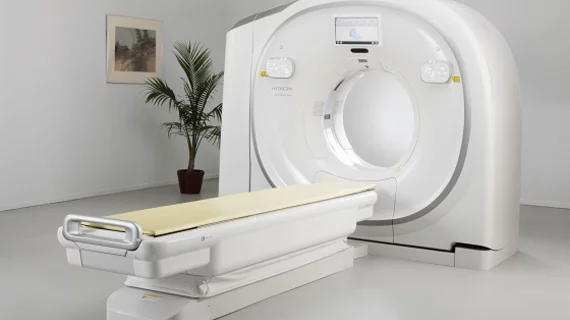Q&A: Getting the Inside Scoop on Hitachi’s New Premium CT System
Hitachi’s newest CT solution, the SCENARIA View 128, has received FDA clearance and is now being installed at hospitals throughout the United States. Jason Miller, Hitachi’s executive director of radiology products, and Richard Pacenta, Hitachi’s executive director of sales, spoke with us about this exciting new solution and what the company has planned for RSNA 2019 in Chicago.
The full conversation can be read below:
What makes the SCENARIA View stand out compared to other CT solutions?
Jason: The first thing we like to point to is the 80-cm patient aperture, which is the largest of any premium 64/128 slice CT system designed for radiology. You’ll see some oncology systems with an aperture of that size, but not systems specifically dedicated to radiology. That larger size gives patients more space, which helps them feel more comfortable and can really help improve that overall patient experience.
The SCENARIA View’s Auto-Lateral Shift Table is another big feature. It moves 20 cm and stands out as a real differentiator. This table gives providers a better overall image quality and even helps limit radiation dose. The system also comes equipped with Hitachi’s latest iterative reconstruction capability, Intelli-IPV, which provides better image quality.
Automatic Data Noise Reduction is another key part of what we do, allowing technologists to get great images when the patient’s arms are down at their sides instead of over their head. And I should mention our SynergyDrive workflow suite, which helps speed up the imaging process from start to finish.
This is going to be your hospital or imaging center’s workhorse, the kind of system that users can depend on in a variety of situations. It’s the system that you have up and ready to use at all times.
Let’s rewind a bit for a moment—can you share a bit about the development of this system?
Jason: Hitachi has been the leader in patient-focused imaging when it comes to MR, so we wanted to carry that over with our CT imaging solutions. That’s where the larger patient aperture and the shifting table came from, for instance, and it’s why we designed a system that we could sell to a wide variety of customers.
We also wanted to make sure the SCENARIA View could accommodate the needs of all patients from all parts of the world. This include rural communities, which have always been a big focus for Hitachi, as well as larger urban areas. That was really important to us, developing a solution that could meet the needs of all patients and clinicians.
You mentioned that the SCENARIA View includes numerous features designed to keep patient dose levels at a minimum. Why was this so important to Hitachi?
Jason: It’s been a priority of the entire industry for the last five or six years, and we’re happy to be a leader in that area. A few years ago, some providers were focused so much on that image quality that they were allowing dose levels get too high. You might have a beautiful, Rembrandt-like image, but you can’t do that if it’s going to lead to way too much radiation. We’re focused on finding the right balance, which means you have that lower dose while still achieving excellent image quality.
Have there been any SCENARIA View installations yet in the United States? I know you just recently gained that crucial FDA clearance.
Richard: Yes, we actually just had our first U.S. installation at the St Joseph’s/Candler Health System, a two-hospital network located in Savannah, Georgia. The health system was already a Hitachi customer and had come to us hoping their next CT solution could be one that worked for all patients, including larger patients. We told them we happened to be finalizing a new CT system that would meet all of their needs, and they were really excited to see it for themselves. They said the excellent experience they had with Hitachi, in terms of both patient comfort and image quality, made it easy to stay with us and upgrade.
We also have more planned installations on the way, including one with 1,000-bed hospital that is going to impact their inpatient, emergency and neurology departments. Of course, the system has also been up and running at facilities across Japan and Europe for some time now.
What are Hitachi’s plans for RSNA 2019 in Chicago? Will the SCENARIA View be on display?
Jason: We will be showing a full range of imaging and IT products at RSNA 2019. The Scenaria View will be one our featured products. Additionally, Hitachi is participating in the RSNA Innovation Theater on Sunday Morning to introduce the SCENARIA View to attendees. Other products on display include our full line of MRI systems. That line is highlighted by Echelon Oval, the widest wide bore 1.5T, and Oasis, the highest field strength open MRI.
Also, Hitachi will be introducing the ARIETTA 850SE, an ultrasound system tailored to address the common challenges faced by radiology departments. The 850SE supports advanced probe technologies such as CMUT and unique applications such as combination elastography, which provides information on hepatic stiffness, attenuation and inflammation for a more complete view of liver health.

